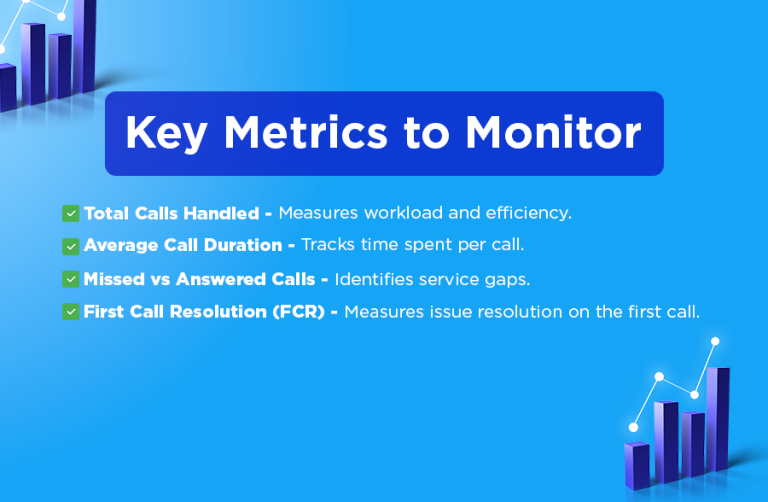Schedule a FREE call with our outsourcing expert now and get a precise quotation that meets your requirements. Don't wait - get started today!
Tracking calls might seem like just another business task, but it holds the key to understanding customer interactions. Think about it—every call is an opportunity. It could be a new lead, a customer needing help, or a chance to improve your service. Yet, many small and medium-sized enterprises (SMEs) struggle to track their total number of calls effectively, often missing out on valuable insights.
Why does this matter? Because without accurate data, you’re making decisions in the dark. Call volume is more than just a number—it reflects your business’s reach, efficiency, and customer engagement. If you don’t know how many calls your outsourced team is handling, how can you measure success? How can you identify peak hours, improve staffing, or ensure customers aren’t waiting too long?
Tracking calls doesn’t have to be complicated. With the right tools and strategies, SMEs can easily see their call operations. Let’s explore the best ways to monitor call volume and why it’s essential for business growth.
Methods To Track the Total Number of Calls in Outsourcing
Tracking the total number of calls in an outsourced setup is essential for managing performance, customer service, and overall business efficiency. SMEs have several methods to do this, ranging from traditional logging to advanced automation. Let’s explore the most effective ways to monitor call volume.
A. Manual Logging: Is It Still Effective?
Some businesses still use spreadsheets or written call logs to track calls. While this method may seem straightforward, it comes with limitations.
Pros:
- No additional costs for software or tools.
- Simple setup without the need for integration.
- Useful for businesses with a low call volume.
Cons:
- Prone to human error, such as missed or duplicate entries.
- Time-consuming for employees to record each call.
- No real-time analytics or automated reports.
Manual logging may work for small businesses handling minimal calls, but as operations grow, this method becomes inefficient and unreliable.
B. Using Call Tracking Software
Call tracking software provides a more structured and automated way to monitor total calls. These tools record call volume, duration, and even caller details. But what should SMEs look for in a tracking tool?
Key Features to Consider:
- Real-time call monitoring – See call activity as it happens.
- Call tagging and categorization – Label calls for better organization and analysis.
- Automated reporting – Get insights without manual data entry.
- Call source tracking – Identify which channels (ads, websites, referrals) generate the most calls.
With the right call tracking software, businesses gain better control over their call data, leading to improved decision-making.
C. Integrating Call Tracking with CRM Systems
A standalone call tracking system is helpful, but integrating it with a Customer Relationship Management (CRM) system makes it even more powerful.
Benefits of CRM Integration:
- Centralized customer data – Track call history alongside customer interactions.
- Better customer insights – Identify frequent callers and their concerns.
- Automated follow-ups – Ensure no leads or customer queries are missed.
- Performance tracking – Measure how well-outsourced teams handle calls.
By combining call tracking with CRM, businesses get a complete view of customer interactions, leading to improved service and engagement.
D. AI and Automation in Call Monitoring
Modern AI-driven tools are changing how SMEs track their total number of calls. Instead of manually logging or relying on basic software, AI enables businesses to automate data collection and gain deeper insights.
How AI Enhances Call Tracking:
- Speech analytics – AI can analyze conversations for keywords and customer sentiment.
- Call transcription – Automatically convert calls into text for record-keeping.
- Automated call categorization – AI can label calls based on their purpose (e.g., sales, support).
- Predictive analytics – Identify trends and potential issues before they impact operations.
AI-powered call monitoring removes human error, saves time, and provides richer insights. For SMEs outsourcing their customer service or sales, this ensures every call is accounted for and analyzed efficiently.

Important Data Beyond Total Call Numbers
While knowing the total number of calls is important, other key performance indicators (KPIs) provide deeper insights into your call center’s efficiency and customer experience. Tracking these metrics helps businesses optimize their call-handling strategies.
1. First Call Resolution (FCR)
FCR measures the percentage of customer issues resolved on the first call without requiring a follow-up. A high FCR indicates efficient problem-solving, reduced customer frustration, and improved operational efficiency. Businesses should aim to increase FCR by providing agents with better training, access to customer history, and clear troubleshooting guidelines.
2. Average Handling Time (AHT)
AHT calculates the average duration of a call, including talk time, hold time, and any after-call work. Monitoring AHT helps businesses assess agent performance and determine whether long calls stem from complex issues or inefficient handling. Reducing unnecessary delays while maintaining quality service can enhance customer experience and optimize resource allocation.
3. Call Abandonment Rate
This metric represents the number of callers hanging up before speaking with an agent. A high abandonment rate often signals long wait times, unclear IVR menus, or insufficient staffing. Businesses should track when and why calls are abandoned to adjust staffing levels, streamline call routing, or introduce self-service options to reduce drop-offs.
By monitoring these metrics alongside total call numbers, businesses gain a comprehensive view of their call center performance, allowing them to refine strategies and enhance customer satisfaction.
4. Peak Call Times
Identifying times when call volumes are highest allows for better staffing and resource allocation, ensuring customer calls are answered promptly.
Hidden Factors That Affect Call Volume Data
Tracking the total number of calls seems straightforward, but several hidden factors can distort your data. Ignoring these elements can lead to inaccurate reporting and poor business decisions. Here’s what to watch out for:
1. Missed Calls and Dropped Calls: Are You Counting Them?
Missed and dropped calls often go unnoticed in call volume reports, yet they provide crucial insights into customer experience and service efficiency. A high number of missed calls might indicate insufficient staffing, technical issues, or long wait times. Similarly, frequent dropped calls could suggest network problems or poor call-handling procedures that frustrate customers and lead to lost opportunities.
2. Multiple Call Transfers: Do They Count as One or Many?
When a customer is transferred multiple times, should it count as a single call or various calls? This inconsistency in counting can misrepresent actual call volume and agent workload. Businesses should define a straightforward method for tracking transfers to ensure accurate reporting and a better understanding of customer journeys. If too many transfers occur, it may signal gaps in agent training or inefficiencies in call routing.
3. Spam and Non-Business Calls: How to Filter Them Out
Not every call received is valuable—spam calls, wrong numbers, and internal employee calls can inflate call volume and distort performance data. Businesses should use call filtering tools, caller ID analytics, and other features to remove irrelevant calls from reports.
By doing so, they can focus on meaningful customer interactions that drive business growth.
4. The Impact of Time Zones on Calla Data
For businesses outsourcing call operations across different regions, time zone differences can affect call patterns and peak hours. If reports aren’t adjusted for time zones, businesses might misinterpret high or low call volumes at certain hours. Tracking calls based on the customer’s local time rather than the agent’s shift can provide a clearer picture of demand and help with staffing decisions.
Accounting for these hidden factors ensures that call volume data accurately reflects business performance. By refining tracking methods, businesses can make better decisions, improve customer service, and optimize resource allocation.
Implementing Effective Call Tracking for SMEs
For SMEs, implementing call tracking doesn’t have to be complex or costly. A structured approach ensures better call monitoring and improved business insights. Here’s how to get started:
1. Choose the Right Tools
Selecting the right call-tracking software is essential for effective monitoring. Businesses should consider their budget, call volume, and required features. Many affordable options provide call recording, real-time analytics, and integration with CRM systems. Some also offer call tagging and AI-driven insights, making it easier to categorize and analyze calls. Choosing a tool that aligns with business needs prevents unnecessary spending while ensuring accurate tracking.
2. Train Your Team
Even the best call-tracking software is ineffective if employees don’t know how to use it properly. Proper training ensures that team members accurately log calls, interpret reports, and use insights to improve customer interactions. Hold training sessions, provide step-by-step guides, and assign experts who can assist with troubleshooting. A well-trained team reduces human error and enhances call-tracking efficiency.
3. Set Clear Objectives
Without clear goals, call tracking data can become overwhelming and underutilized. SMEs should define what they want to achieve—improving customer service, increasing sales, or measuring the effectiveness of marketing campaigns. Setting specific key performance indicators (KPIs), such as call response time, missed calls, or conversion rates, helps businesses stay focused and measure progress effectively.
4. Regularly Review and Adjust
Call tracking is not a one-time setup; it requires continuous monitoring and improvement. Regularly reviewing data helps identify patterns, peak call hours, and areas where customer service can be enhanced. If call volume suddenly drops or customer complaints increase, adjustments can be made quickly. Businesses should also be open to upgrading tools, adding automation, or modifying call-handling procedures based on insights from their tracking data.
By following these steps, SMEs can implement a reliable call-tracking system that boosts efficiency, improves customer service, and enhances decision-making without unnecessary complexity or costs.
Partnering with the Right Outsourcing Provider
Choosing an outsourcing partner who values transparency and provides detailed call metrics is crucial. At Magellan Solutions, we understand the importance of comprehensive call tracking for SMEs. Our services include regular reporting and access to real-time data, ensuring you’re always informed about your business operations.
Accurate call tracking is essential for business growth. Book your FREE 60-minute business consultation with Magellan Solutions today. Let’s strategize on elevating your operations—NO COMMITMENTS, just results-driven insights! Our services include inbound and outbound calling, customer support outsourcing, and more.
















